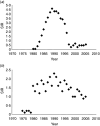Epidemiology of classic and AIDS-related Kaposi's sarcoma in the USA: incidence, survival, and geographical distribution from 1975 to 2005
- PMID: 22404880
- PMCID: PMC9152052
- DOI: 10.1017/S0950268812000325
Epidemiology of classic and AIDS-related Kaposi's sarcoma in the USA: incidence, survival, and geographical distribution from 1975 to 2005
Abstract
This study aimed to examine trends in incidence, geographical distribution, and survival of classic and AIDS-related Kaposi's sarcoma (KS) in the general US population using Surveillance, Epidemiology, and End Results (SEER) tumour registries with 12 066 patients diagnosed with KS between 1975 and 2005. Although the age-adjusted standardized incidence ratio (SIR) of AIDS-related KS (1·9) during 1980-2005 was not significantly higher than that of classic KS (1·4) during 1975-2005 (P = 0·78), the trends in annual SIR rates revealed distinct patterns. While the SIR for AIDS-related KS declined across all registries from the early 1990s (4·6) to late-1990s (0·3) (P = 0·05), the SIR of classic KS remained relatively steady (1·7). In both forms the SIR of KS was highest in metropolitan areas. The 5-year survival rates for patients with AIDS-related KS improved from 12·1% (1980-1995) to 54% (1996-2005) (P = 0·05). Survival rates for patients with classic KS remained stable, ranging from 75·7% to 88·6% during the 30-year period. These results may reflect improved HIV treatment.
Figures


References
-
- Bagni R, Whitby D. Kaposi's sarcoma-associated herpesvirus transmission and primary infection. Current Opinion in HIV and AIDS 2009; 4: 22–26. - PubMed
-
- Gazouli M, et al. Human herpesvirus type 8 genotypes in iatrogenic, classic and AIDS-associated Kaposi's sarcoma from Greece. Anticancer Research 2004; 24: 1597–1602. - PubMed
-
- Rosenberg PS, Biggar RJ. Trends in HIV incidence among young adults in the United States. Journal of the American Medical Association 1998; 279: 1894–1899. - PubMed
-
- Biggar RJ, Curtis RE, Cote TR, Rabkin CS, Melbye M. Risk of other cancers following Kaposi's sarcoma: relation to acquired immunodeficiency syndrome. American Journal of Epidemiology 1994; 139: 362–368. - PubMed
-
- Osmond DH, et al. Prevalence of Kaposi sarcoma-associated herpesvirus infection in homosexual men at beginning of and during the HIV epidemic. Journal of the American Medical Association 2002; 287: 221–225. - PubMed
MeSH terms
LinkOut - more resources
Full Text Sources
Medical

